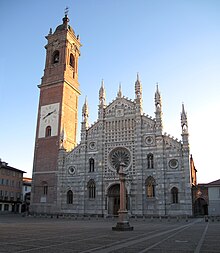Monza Cathedral
| Basilica of St John the Baptist Duomo di San Giovanni Battista (Italian) |
|
|---|---|

Façade of the Duomo
|
|
| Basic information | |
| Location | Monza, Italy |
| Geographic coordinates | 45°35′01″N 9°16′33″E / 45.58353°N 9.275787°ECoordinates: 45°35′01″N 9°16′33″E / 45.58353°N 9.275787°E |
| Affiliation | Catholic |
| Rite | Latin Rite |
| Province | Archdiocese of Milan |
| Country | Italy |
| Architectural description | |
| Architectural style | Italian Gothic |
| Groundbreaking | 1300 |
| Completed | 1681 |
| Direction of façade | West |
The Duomo of Monza (Italian: Duomo di Monza) often known in English as Monza Cathedral is the main religious building of Monza, near Milan, in northern Italy. Unlike most duomos it is not in fact a cathedral, as Monza has always been part of the Diocese of Milan, but is in the charge of an archpriest who has the right to certain episcopal vestments including the mitre and the ring. The church is also known as the Basilica of San Giovanni Battista from its dedication to John the Baptist.
The basilica, which would in essence have been complete by 603 when heir to the Lombard throne Adaloald was baptised here by Secundus of Non, is believed to have been commissioned towards the end of the seventh century by the Lombard Queen of Italy, Theodelinda, as a royal chapel to serve the nearby palace. According to the legend she had made a vow to build a church dedicated to Saint John the Baptist, and when riding along the banks of the Lambro River, she was halted by a dove who told her Modo (Latin for "now"), to which she replied Etiam ("yes"). Monza itself was initially known as Modoetia.
In 595, she had a oraculum (chapel) built on the Greek Cross plan; of this chapel only the walls exist today. The queen was buried here, in what is now the central left aisle of the church. On the remains of the oraculum, a new church was erected in the 13th century. It was again rebuilt as a basilica, starting from 1300, on a Latin Cross plan with an octagonal tiburium. In the late 14th century, the side chapels were added and, as designed by Matteo da Campione, the Pisan-Gothic style west front in white and green marble was begun.
...
Wikipedia
